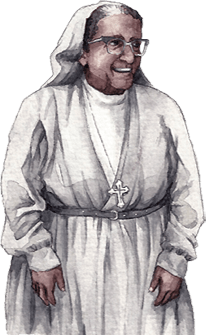Photos, Audios & Videos > Audios > Textos Complementares
Audios
Complementary Texts
Hymn for Sister Benigna
The lyrics and the music of this hymn were composed by Maria Virginia Ferreira Sampaio, as a request from a devotee who, knowing her musical skill, made her this request. From a religious family, she has already composed several songs. She got to know about the history of Sister Benigna’s through facts, testimonies she was told and from the book, which tells the life story of Servant of God, and so she became a devotee as well.
Sister Benigna
“Sister Benigna” is a song especially composed for the Association of Friends of Sister Benigna – Amaiben, inspired in songs from the colonial period of Minas Gerais, particularly in the songs of the composer José Joaquim Emerico Lobo de Mesquita. In this song, the theme melody of Amaiben, which was composed by Ana Beatriz Lucas dos Santos, appears twice.
The song “Sister Benigna” was composed in six parts:
Andantino: Theme song of Amaiben: French Horn solo (Horn).
Allegro: Flute, horn, strings.
Andantino: Voice Trio: contralto and tenor.
Andantino: Theme song of Amaiben: French Horn solo (Horn).
Allegro: Flute, horn, strings.
Andante: Continuous French horn solo and contralto solo.
Participating Musicians:
Maria Teresa Barbosa: voice of first contralto solo and second contralto.
Alexandre Lisboa: French horn.
Elmo Sepúlveda: composition, arrangement, new voice guo flute, tenor voice.
"General Quartet":
Rafael Marcenes: first violin.
Andre Taciano: second violin.
Marcos Reis: viola.
Geter Fernandes: cello.
Recording:
Estudio 10, located in Belo Horizonte, on June 24th, 2012.
Mixing: Leonardo Barcellos.
Amaiben’s Theme Song
Initially, the music composed by Ana Beatriz Lucas dos Santos was entitled "I want to be a Friend of Sister Benigna".Later, the singer-songwriter, Dinilson Barbosa da Silva, made a review of the same song, this time, on seresta rhythm; very much appreciated by the Servant of God in life, being a citizen born in the city of Diamantina, the birthplace of the seresta.
By portraying the journey of life of Sister Benigna since her birth, it became then the hymn of the Association of Friends of Sister Benigna - Amaiben.
Joy of the Soul
Composition of Ana Beatriz Lucas dos Santos (music and lyrics), "Joy of Soul" depicts one of the most striking features of the Servant of God, her sweet and sincere smile and the joy she kept at all times of her life.
When she went somewhere and noticed sadness in the hearts of people, Sister Benigna used to ask for a guitar and begin singing. Only then she would start praying, feeling that people were already more open to her words.
Victim of Jesus
Written by Ana Beatriz Lucas dos Santos (music and lyrics), Victima de Jesus was inspired on the stories of the book “The Most Beautiful Stories of Sister Benigna” and highlights a virtue recognized by all her devotees: the donation. Every time she had and everything she had was always given to those most needed.
Mary
Authored by Fabio Roniel, (Canção Nova Community), the song Maria remit us to the contemplation of the Virgin Mary, her perfect obedience, her total surrender to God.
Sister Benigna, while alive, taught the devotion to Our Lady to so many people, the praying of the rosary, the prayer of the Hail Holy Queen. She deeply loved Our Lady, and translated such love in works, in favor of everyone.
Blessed Calyx
Pickup of Brazilian folklore and adapted by Tavinho Moura, an internationally recognized musician from Minas Gerais State, the song Blessed Calyx spread further in the voice of the renowned singer-songwriter Milton Nascimento, being recorded by him in 1976. Inserted in the manifestations of Folia de Reis (popular Christmas auto, of Portuguese origin, recalling the visit of the Three King to the Baby Jesus), Blessed Calyx is also an expression of the faith of the people, who praises the Child Jesus and Our Lady
José Joaquim Emerico Lobo De Mesquita (1746 - 1805)
The freed José Joaquim Emerico Lobo de Mesquita was born in Serro do Frio, Serro (MG). Son of a Portuguese father and the slave Joaquina Emerenciana as his mother, he turned out to be one of the most important composers of classical music in Brazil, a well-known name of sacred music of the XVIII century.
Organist, conductor and composer, patron of the chair number 4 at Brazilian Academia of Music, he was the musician of the troop paid to protect the captaincy of Minas Gerais, with a Alferes rank. He is considered as the most expressive seventeenth century composer of Minas Gerais. He studied music with the Father Manuel da Costa Dantas, master of chapel for the Main Church of Our Lady of Conception. He headed to Arraial do Tijuco (1776), today known as Diamantina, in charge of installing a church organ manufactured by the Father Manuel de Almeida Silva at the Main Church of Santo Antônio, where he developed his carrier as both an organ player and composer (Regina Caeli Laetare, 1779), until he joined the religious order of Third Order Of Our Lady of Carmo (1789). Alferes of the Third of Infantry of the Brown, he was in charge of an oratory for the Holy Week (1792). He conducted the music for the Triduum of the period (1798-1799) at the Main Church of Our Lady of the Pilar in Ouro Preto, and the Forty Hours, for the next period (1800-1801). Until his death, he played in Church masses of the Third Order of Carmo in Rio de Janeiro, where he died in 1805. One of his Offices of the Dead was performed in Vila de Caetés, MG, in 01/25/1827 in memory of Empress Leopoldina, which confirms the fact that the composer was recognized even his twenty years after his death.
The most significant of his works are, among others: Antiphon of Our Lady (Regina Caeli Laetare and Ave Regina Caelorum) and Salve Regina (1787), Holy Mass in em Fá (1780) and Holy Mass of Mi Bemol (1782), Dominica in Palmis (1782), one of the rarest original works of the composer and the motet Tercio (1783), considered as the most ancient scores of a Brazilian composer.
Dinilson Barbosa
Dinilson Barbosa da Silva was born with that innate light that never ends. Expression of a true and inspired talent, guitar expert, excellent singer, privileged interpreter of both (voice and guitar), music teacher and composer. Romantic, he interprets our beautiful MPB. At the age of eight, he had already begun his music learning process. Simplistic and at the same time refined on his presentations, Dinilson Barbosa is serious, focused, and he is always allured while singing a song. (Nadir Lanza – Fatoral – Sete Lagoas, February of 1998).
Ana Beatriz Lucas Dos Santos
Ana Beatriz Lucas dos Santos, from Belo Horizonte, is a pedagogue, post graduated in Children’s Education. Her nonacademic musical qualification started when she was a teenager. Self-taught, she began to show her passion for music through the guitar. She used to play at children’s religious parties, cheering the Confirmation Course in her parish. She got to know the devotion to the Servant of God, Sister Benigna through Mrs Maria do Carmo Mariano - President of Amaiben - and obtained inspiration for her songs in the book "the most beautiful stories of Sister Benigna".


